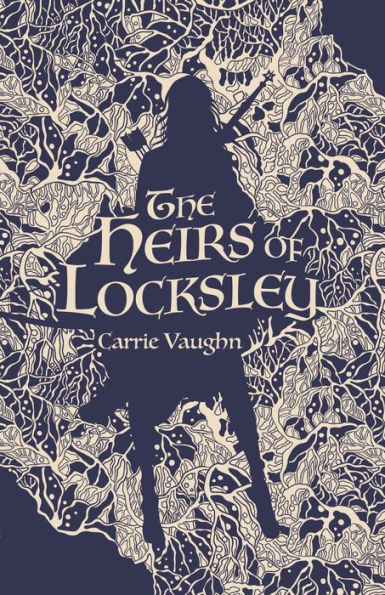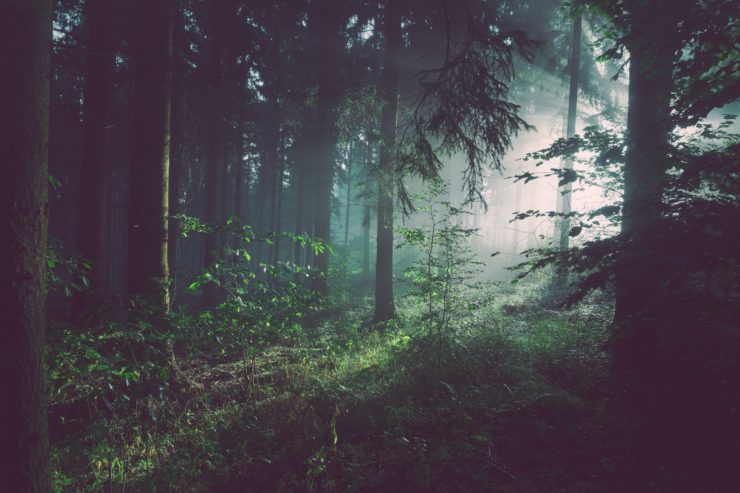Give me your Fangorns and your Lothloriens, your Green Hearts and your Elvandars. Evoke your Haunted Forest Beyond the Wall complete with creepy weirwoods, your Steddings and your Avendesoras. Send me pleasant dreams about Totoro’s Japanese Camphor and the Forest Spirit’s kodama-filled canopy. Or, y’know, tree cities full of Wookiees instead of elves. I will take them all!
Forests in speculative fiction novels have a special place in my heart. Especially tree-cities.
In real life, all forests seem magical to me. I can’t think of a culture that has not populated them with myths or religious figures. In Australia, First Nations people will tell you about ancient spirits dwelling in our forests whether tropical, temperate or dry. Proud Lebanese will tell you that their cedar forests were used for Solomon’s Temple and to build Noah’s ark. They may not know that those same cedar forests appeared in the Epic of Gilgamesh, circa 2100 BC. Those heroes fought off monsters and cut down the trees. In contrast, the characters of Dan Simmons’ Hyperion travel on treeships beyond the stars…
Take me there. I’m with you! As long as trees are, too.
Here are a mere eight of my favourite fictional forests:
The Magic Faraway Tree by Enid Blyton
When telling people I’ve written a novel about a magical forest, the most common response so far has been: “You mean like The Magic Faraway Tree?” This staple of English-speaking childhoods was indeed beloved by my smallish self, not only for the magic tree which grew all kinds of leaves, fruit and nuts on the one plant but the vast cast of magical creatures which made the tree their home.
The Jungle Books by Rudyard Kipling
Of course, the jungles of the subcontinent aren’t fictional. It’s just that this was the first book where I saw a wilderness treated remotely in fiction like an ally and protector, with its own languages and laws, instead of a hostile thing to be conquered. Wiser people than I have much valid criticism to heap on this book, and yet I still sometimes dream of stretching out on a rainforest limb beside Bagheera and Baloo.
Robin Hood
Ah, Sherwood Forest. Again, a real forest, populated by larger than life characters. Sherwood has been a forest since the end of the last ice age, apparently, and yet one man, the King of England, “owned” every deer in it. Ha! I have my suspicions about what the druids would have had to say about that. Ancient oaks, here as elsewhere, form the heart of this forest, including the one that famously served as the archer-thief’s hideout.
Buy the Book


The Heirs of Locksley
The Hobbit and The Lord of the Rings by J. R. R. Tolkien
The Hobbit and The Lord of the Rings seem to be about dwarves, elves and metaphors for sensible, down-to-earth English folk, but really, it’s all about the trees. More, it’s about how trees are good and the industrial revolution is bad.
Tolkien lovingly names and describes them—oak, ash, beech, birch, rowan, willow. Tom Bombadil, a forest god, and Goldberry, a river goddess, seem the only incorruptible aspects of Middle Earth. Baddies cut trees down. Goodies, in contrast, reside in or amongst trees. Or hide in them from wargs. Galadriel’s magic sustains the Mallorn trees of Lothlorien which, instead of losing their leaves, turn golden and glitter. These trees, along with others of Mirkwood, the Old Forest and Fangorn can accumulate wisdom, act in the interests of good or evil, and are as beautiful, vital and alive as the speaking characters.
The Lorax by Dr. Seuss
“I am the Lorax, I speak for the trees!”—yes, I have been known to utter this in despair at parties when developers ask in all innocence why I don’t seem excited by the innovative architectural design. Even a toddler can grasp that when the last truffula tree is cut down, and the swomee-swans, humming fish and bar-ba-loots are gone, all the money in the world can’t save your soul, and it doesn’t matter that the glorious truffula forest is completely made up.
The Word for World is Forest by Ursula K. Le Guin
The title says it all, really (it’s a great title, isn’t it?) With it, Le Guin reminds us that our home planet is “Earth.” In many science fiction stories, including this one, we appear as “Terrans.” We’re all about the dirt, not the ecosystems supported by it, not just because agriculture is the basis of Western civilisation but because our religions or philosophies of superiority rely on separating ourselves from “lower” forms of life.
Walking the Tree by Kaaron Warren
The title says a lot here, too. In this fantasy world, Botanica, a continent dominated by a single mammoth tree is circumnavigated by girls in a five-year-long rite of passage. Walking the Tree is a strange and beautiful book with a complicated, likeable protagonist to keep us company on our journey across the colourful patchwork of her world.
The Broken Kingdoms by N. K. Jemisin
Like Warren’s work, the second book of Jemisin’s Inheritance trilogy is set beneath the canopy of a single, enormous tree. I loved the transformative power of this tree, the monolithic inability to ignore it. The rustle of its leaves was part of the music of this rather musical book—the main character couldn’t see—and the roots and branches grew and disturbed the order of the city of Shadow. But also, as with the Warren, the tree was a power that divided people, as opposed to bringing them together.
This article originally appeared in the Tor/Forge newsletter. Join the mailing list here.
Read an excerpt from Thoraiya Dyer’s Crossroads of Canopy here.
 Thoraiya Dyer is an Aurealis and Ditmar award-winning, Sydney-based writer and lapsed veterinarian. Her short science fiction and fantasy has appeared in Clarkesworld, Apex, Cosmos, Analog and various Australian and US anthologies. Four of her original stories are collected in “Asymmetry,” available from Twelfth Planet Press. Her first novel is Crossroads of Canopy. She is @ThoraiyaDyer on Twitter.
Thoraiya Dyer is an Aurealis and Ditmar award-winning, Sydney-based writer and lapsed veterinarian. Her short science fiction and fantasy has appeared in Clarkesworld, Apex, Cosmos, Analog and various Australian and US anthologies. Four of her original stories are collected in “Asymmetry,” available from Twelfth Planet Press. Her first novel is Crossroads of Canopy. She is @ThoraiyaDyer on Twitter.











The mountain-trees that the Raksura have colonies in, in Martha Wells’s series that begins with The Cloud Roads. (The trees don’t show up until the second book, though.) They are fascinating ecosystems and living places.
Martha Wells’s Raksura series include some beautiful forests and tree dwellings.
I feel like I should mention Below the Root, by Zilpha Keatley Snyder (The Green Sky trilogy).
Richard Powers’s The Overstory is about our modern relationship with forests. Not a very happy story, unfortunately.
Stephen R. Donaldson’s Thomas Covenant series includes several unique tree elements, including the tree city of Revelwood (a giant banyan), the Forestals (the incarnate soul of a forest) and the One Tree (kind of like Yggdrasill, the Norse world tree).
First one that springs to mind is the myth-haunted forest in Robert Holdstock’s Mythago Wood and sequels.
Couple of cool alien forests crop up in Brian Stableford’s books – the forest of Chao Phrya in Promised Land, the world-spanning forest of Dendra in Critical Threshold: both of them hold dangers, and secrets.
Alan Dean Foster’s “Mid-World” is a forest world where the trees, and the plants that live on and around them, will eat the unwary traveller alive
I must mention the memorable Hlutr, alien tree-people of Don Sakers’ The Leaves of October, which I found out about in the comments of a Tor post.
I yearn for the day when someone (possibly a Native/First Nations/indigenous author) writes a magical forest of sugar maples. The sugar maple, providing sustenance when people were starving towards the end of particularly long & hard winters, was recognized as the tree of life by at least one Native culture. I’ve had enough of British fantasy realms with oak, ash, beech and elm. Nothing is more magical than a sugar maple! Gives you delicious food in late winter before any other foodstuff is growing, *and* transfigures the landscape with the most vibrant colors in the fall!
L. Sprague de Camp wrote a lovely maple dryad in “The Hardwood Pile,” the closest I’ve found to maple magic in fantasy, but she’s a Norway maple, not a sugar maple.
Kind of missed the ur-forest story, I think … and it depends on one’s definition of civilization, presumably, but seems rather slight to consider a sedentary society that would meet the basics of stability and material culture that one would expect that didn’t depend on agriculture.
Not exactly a forest, but the Smoke Ring around Levoy’s Star is populated by, among other things, 100-kilometre long trees shaped like integral signs in Larry Niven’s The Integral Trees.
The first two novels in the Queens of Renthia series by Sarah Beth Durst are set in a massive forest of massive trees and smaller but massively-dangerous nature spirits.
Alan Dean Foster, who as far as I know is still being stiffed over his Star Wars royalties, set his Midworld in a global rain forest of the sort imagined by someone who had never been to a tropical rain forest.
Wendy N. Wagner’s An Oath of Dogs is set in what seems to be a temperate rain forest on an alien world. As the characters discover, there are some significant differences between our temperate rain forests and the one on Hugin.
Barsoom has some forests with gigantic technicolor trees dripping gorgeous flowers, delicious fruits and nuts, and unfortunately nasty, carnivorous plant life to spoil it all.
and what about the Mythago Wood saga ? If there’s a “forest” world for me, it’s here
The Tree in Sharon Lee & Steve Miller’s Korval books has a mind all its own, & is a very significant recurring character.
I’m always surprised to find that The Trees by Ali Shaw has not been more widely read, or at least more widely remarked upon. The premise is that one day a vast primeval forest suddenly springs into being all across the face of Earth. It’s replete with beauties and dangers. Survival horror and unexpected heroism ensue.
Second the sentient Tree of Korval – love the imagery in Crystal Soldier of these forest giants who fell in the fight against the enemy, leaving only the small seedling who a millenium later is Korval’s Tree and Elder of the Clan.
There is a haunted wood in Rewards and Fairies.
They shut the road through the woods
Seventy years ago.
Weather and rain have undone it again,
And now you would never know
There was once a road through the woods
Before they planted the trees.
It is underneath the coppice and heath,
And the thin anemones.
Only the keeper sees
That, where the ring-dove broods,
And the badgers roll at ease,
There was once a road through the woods.
Yet, if you enter the woods
Of a summer evening late,
When the night-air cools on the trout-ringed pools
Where the otter whistles his mate,
(They fear not men in the woods,
Because they see so few.)
You will hear the beat of a horse’s feet,
And the swish of a skirt in the dew,
Steadily cantering through
The misty solitudes,
As though they perfectly knew
The old lost road through the woods.
But there is no road through the woods.
[Rudyard Kipling, The Way through the Woods, 1910]